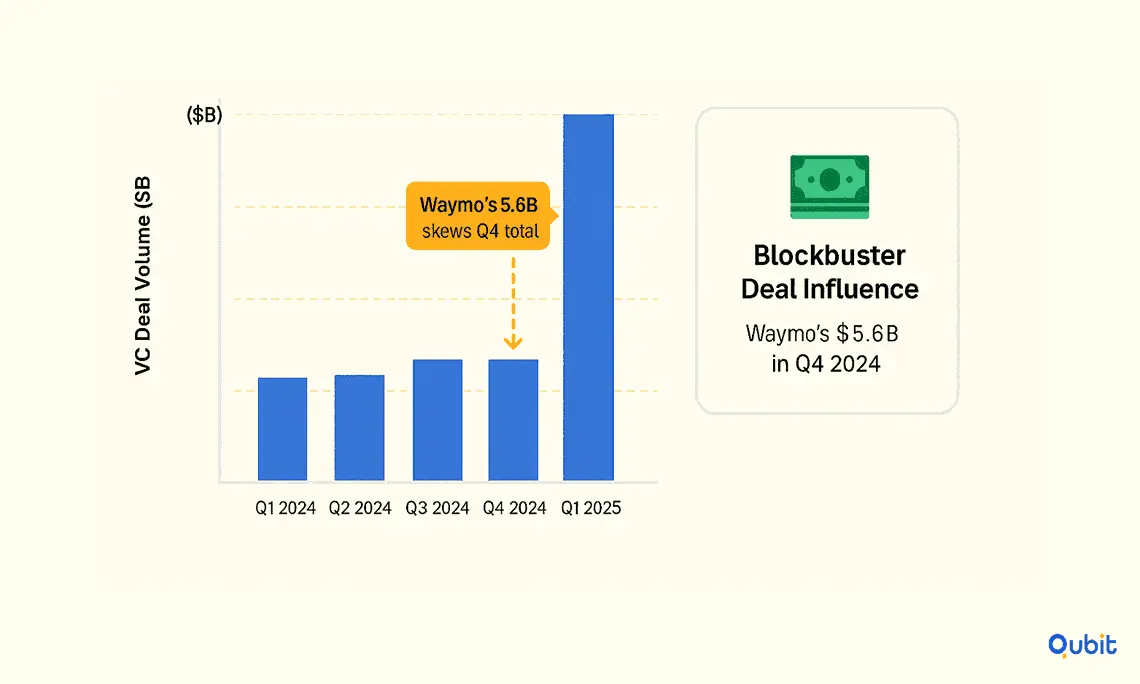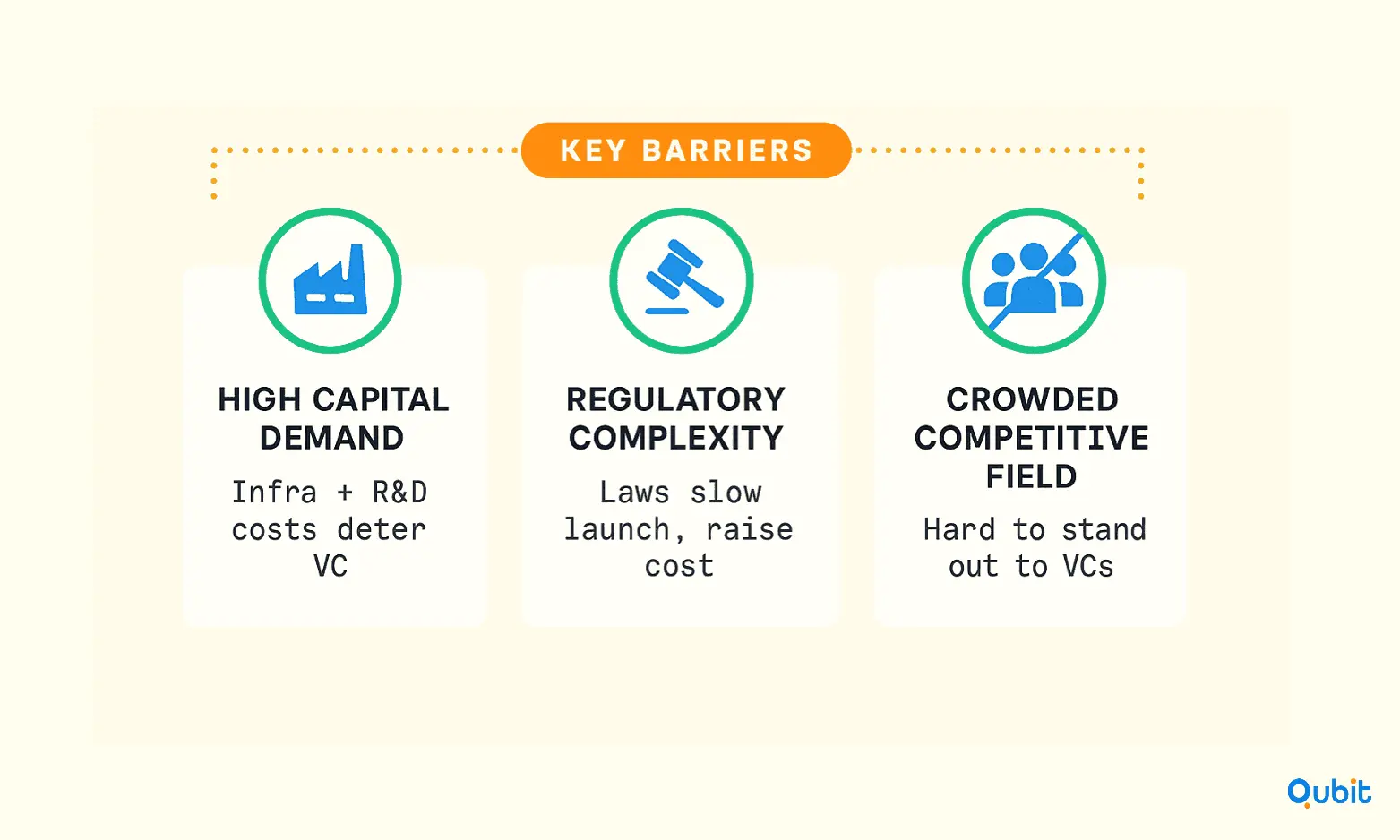The surge in global VC funding for EV, battery, and mobility startups reflects the growing demand for sustainable transportation solutions. In 2023 alone, mobility startups attracted $39 billion in funding, underscoring the sector's immense potential. This article delves into the latest trends shaping venture capital investments in these industries, exploring the factors driving growth and the opportunities for startups to secure funding.
For those seeking actionable insights, you find a comprehensive perspective in the article when exploring mobility startup fundraising strategies that detail various approaches and funding options tailored to mobility ventures.
Stay tuned as we uncover the evolving investment landscape, highlighting the key drivers and emerging opportunities in the EV, battery, and mobility sectors.
Evolving Trends Mobility Tech
The mobility tech is undergoing rapid transformation, fueled by advancements in electrification, autonomous systems, and connectivity. As urbanization accelerates and environmental concerns grow, the sector has become a focal point for innovation and investment. From electric vehicles (EVs) to shared mobility platforms, the industry is reshaping how people and goods move across cities and beyond.
Key players such as Tesla, Uber, and Waymo are driving the adoption of cutting-edge technologies, while emerging startups continue to challenge traditional models. The integration of artificial intelligence and machine learning into mobility solutions is enabling smarter, more efficient systems. These innovations are not only enhancing user experiences but also addressing critical issues like congestion and emissions.
Investor behavior is shifting as the sector matures. A detailed discussion on investor behavior is presented in mobility VC risk appetite, which examines shifts in capital allocation within established mobility platforms. This evolution highlights how venture capitalists are increasingly favoring proven technologies and scalable business models over high-risk experimental ventures.
Electrification remains a cornerstone of the industry's growth, with advancements in battery technology and regulatory incentives accelerating adoption. Governments worldwide are implementing policies to support EVs and sustainable mobility solutions, creating new opportunities for businesses to thrive.
Mapping the VC Ecosystem in Mobility Tech
The venture capital (VC) ecosystem in mobility tech is a dynamic network that connects startups, investors, and strategic partners. This ecosystem plays a pivotal role in driving innovation across electric vehicles (EVs), autonomous systems, and shared mobility solutions. Understanding its structure is essential for startups aiming to secure funding and scale their operations effectively.
Key Players in the Mobility Tech VC Ecosystem
Venture Capital Firms
VC firms are at the heart of funding mobility tech startups. They focus on high-growth potential areas like EV infrastructure, autonomous driving technologies, and mobility-as-a-service (MaaS) platforms. These firms often provide not just capital but also mentorship and industry connections.Corporate Investors
Large corporations, particularly in the automotive and energy sectors, are increasingly investing in mobility tech. Their involvement often stems from a strategic interest in integrating innovative solutions into their existing operations.Angel Investors
Angel investors are crucial for early-stage startups. They typically bring niche expertise and are more willing to take risks on unproven technologies.Strategic Partnerships
Collaborations between startups and established companies can accelerate product development and market entry. These partnerships often involve co-investment opportunities.
Insights for Startups
For mobility tech startups, identifying the right investors is critical. Insights into targeted investment approaches emerge in pitch EV investors mobility startups, where the discussion addresses nuances in connecting with EV-focused financiers. This resource highlights how startups can align their pitches with the priorities of investors specializing in mobility tech.
The VC ecosystem in mobility tech is a complex yet rewarding landscape. By understanding the roles of various stakeholders and tailoring their approach, startups can position themselves for success in this rapidly evolving industry.
Analyzing VC Activity in Mobility Tech
The mobility tech sector continues to attract significant venture capital (VC) interest, with deal volumes and values reflecting the industry's dynamic growth. One standout example is Waymo’s $5.6 billion round, which was described as the blockbuster mobility tech deal for Q4 2024. This statistic highlights how a single high-profile round can significantly influence quarterly deal totals, underscoring the importance of tracking major transactions in the sector.

Shifting Trends in Investment Focus
VC activity in mobility tech is evolving, with investors increasingly targeting areas like autonomous vehicles, electric mobility, and shared transportation platforms. High-value deals, such as Waymo’s, not only capture headlines but also signal where the industry's future lies. These investments often serve as benchmarks, shaping the expectations for both startups and investors.
Evaluating Investor Compatibility
For startups aiming to secure funding, understanding how to choose the right mobility investor is critical. Analytical perspectives on investor compatibility are offered in how to choose the right mobility investor, emphasizing considerations of strategic alignment and long-term objectives. This ensures that startups partner with investors who share their vision and can provide more than just financial backing.
The Bigger Picture
While blockbuster deals like Waymo’s dominate the narrative, smaller transactions also play a vital role in fostering innovation. These deals often support emerging technologies and niche markets, contributing to the sector's overall growth. By examining both large and small investments, stakeholders can gain a comprehensive understanding of the trends shaping mobility tech.
As the sector continues to mature, the interplay between high-profile rounds and smaller, strategic investments will define the trajectory of mobility tech funding.
Summary of Key VC Deals in Mobility Tech
Recent venture capital activity in mobility technology has showcased a dynamic mix of seed investments, Series A rounds, and mega-deals that are reshaping the industry. From autonomous vehicle startups to electric mobility platforms, these transactions highlight the growing investor confidence in innovative solutions addressing transportation challenges.
Seed and Early-Stage Investments
Seed funding rounds have been pivotal in nurturing emerging mobility startups. Companies focusing on AI-driven traffic management and micro-mobility solutions have attracted significant attention. These early investments often aim to validate concepts and scale prototypes, setting the stage for larger funding rounds.
Series A and Growth Rounds
Series A deals have seen a surge in funding for startups specializing in fleet optimization and shared mobility platforms. These rounds typically focus on scaling operations and expanding market reach. Notably, several Series A transactions have been accompanied by strategic partnerships with automotive giants, further solidifying the startups' market position.
Mega-Rounds and Industry Giants
Mega-rounds, often exceeding $100 million, have been dominated by autonomous driving technology and electric vehicle manufacturers. These deals underscore the industry's shift toward sustainable and tech-driven transportation solutions. Such transactions not only provide substantial capital but also signal broader market trends, influencing investor strategies across the sector.
Alternative funding methods are elaborated upon in mobility startup crowdfunding syndicate, where diverse models for raising capital through collective efforts are explored.
Comprehensive Overview of VC Funding in EV, Battery & Mobility Startups
The electric vehicle (EV), battery, and mobility sectors have emerged as pivotal areas for venture capital (VC) funding, reflecting a shift in investor priorities toward sustainable technologies. In 2023, global mobility startup funding reached an impressive $39 billion, showcasing the sector’s resilience despite a plateau in deal counts. This resilience is further highlighted by the increased average round size of $52 million, signaling growing confidence in the scalability of EV-related technologies.
Shifting Trends in VC Funding
VC funding in EV startups continues to dominate the mobility landscape, driven by advancements in battery technology and the push for decarbonization. Investors are increasingly focusing on startups that offer innovative solutions, such as next-generation battery systems and autonomous mobility platforms. This shift underscores the evolving priorities of venture capitalists, who are now favoring technologies with long-term environmental and economic impact.
Regional Opportunities in Mobility Tech
Trends specific to regional opportunities are highlighted in mobility tech startup funding in India, shedding light on evolving investment landscapes in transportation and logistics tech. This regional focus demonstrates how localized innovation is contributing to global funding totals, further diversifying the market.
Resilience Amidst Plateauing Deal Counts
Despite a plateau in the number of deals, the mobility sector has shown remarkable resilience. The increased average round size indicates that investors are concentrating their resources on fewer, high-potential startups. This approach not only reflects a strategic shift but also reinforces the confidence in the scalability and profitability of EV-related technologies.
As the mobility sector continues to evolve, understanding these funding trends is crucial for startups aiming to secure investment. Whether focusing on EV startup funding or battery startup investment, the data highlights the importance of innovation and scalability in attracting venture capital.
Factors Driving Investment in the Mobility Sector
The mobility sector is undergoing a transformative shift, fueled by a combination of technological advancements, policy support, and changing consumer preferences. These investment drivers are reshaping the industry, creating opportunities for both established players and emerging startups.
1. Government Incentives and Policy Support
Regulatory frameworks and government incentives are playing a pivotal role in accelerating investments in mobility. Subsidies for electric vehicles (EVs), tax benefits for renewable energy adoption, and infrastructure development programs for EV charging stations are reducing barriers to entry. These measures not only lower capital risks but also encourage private investors to fund innovative solutions.
2. Consumer Demand for Sustainable Solutions
The growing awareness of environmental issues is driving consumers to seek greener alternatives. This shift in demand has spurred investments in electric vehicles, shared mobility platforms, and public transportation systems. Companies that align with these sustainability goals are attracting significant venture capital, as investors recognize the long-term potential of eco-friendly solutions.
3. Breakthroughs in EV and Battery Technology
Technological innovation is another critical factor shaping the mobility sector. Advancements in battery technology, such as increased energy density and reduced costs, are making electric vehicles more accessible to the mass market. Similarly, developments in autonomous driving and connected vehicle systems are opening new avenues for investment, promising safer and more efficient transportation networks.
4. Reduced Capital Risks Through Innovation
Supportive policies and technological breakthroughs are mitigating traditional investment risks. For instance, the integration of renewable energy sources with mobility solutions is reducing operational costs, while data-driven insights are enabling better decision-making. These factors are fostering investor confidence and stimulating growth in the sector.
As the mobility landscape continues to evolve, understanding these investment drivers is essential for stakeholders aiming to capitalize on emerging opportunities. Whether it's through government-backed initiatives or consumer-driven demand, the sector is poised for sustained growth.
Could you please specify which section you'd like me to generate content for?
Innovative Trends Shaping VC Funding in Mobility
The mobility sector is undergoing a transformative phase, with emerging trends redefining how venture capital (VC) funding flows into the industry. Investors are increasingly drawn to groundbreaking technologies and sustainable solutions that promise to reshape transportation.
Expanding Horizons with Advanced Air Mobility
One of the most exciting developments is the rise of advanced air mobility, which has achieved its highest deal value since 2021. This trend highlights how the definition of "mobility" is broadening to include aerial innovations. From urban air taxis to drone delivery systems, these advancements are capturing the imagination of both investors and consumers. The integration of such technologies signifies the widening scope of mobility to include aerial initiatives, opening up new avenues for growth and investment.
The Role of Sustainability in VC Decisions
Sustainability is becoming a cornerstone of VC funding strategies. Startups focusing on battery recycling are gaining traction as the demand for electric vehicles (EVs) surges. These companies are addressing critical challenges in the EV ecosystem, such as reducing waste and ensuring the availability of raw materials for future production. This focus aligns with global efforts to create a circular economy and reduce the environmental impact of transportation.
Mobility-as-a-Service (MaaS) Platforms on the Rise
The growth of Mobility-as-a-Service (MaaS) platforms is another significant trend shaping the industry. These platforms integrate various modes of transportation into a single, user-friendly service, offering convenience and flexibility to consumers. As urbanization accelerates, MaaS solutions are becoming indispensable, attracting substantial VC interest.
Obstacles in Acquiring VC Investments for Mobility Ventures
Securing venture capital (VC) funding can be a daunting task for mobility startups, especially given the unique challenges they face in this sector. From high capital demands to navigating complex regulations, mobility ventures often encounter significant hurdles in their quest for investment.

1. High Capital Requirements
Mobility startups typically require substantial upfront investment to develop infrastructure, technology, and operational systems. This high capital demand often deters VC firms, as they may perceive the risk as outweighing potential returns. For example, building electric vehicle charging networks or autonomous vehicle systems involves extensive R&D and operational costs, making it harder to attract funding.
2. Regulatory and Compliance Barriers
The mobility sector is heavily regulated, with startups needing to comply with stringent laws related to safety, environmental standards, and urban planning. These compliance requirements can delay product launches and increase operational costs, discouraging investors who prefer quicker returns.
3. Intense Market Competition
The mobility industry is saturated with established players and emerging startups, all vying for market share. This fierce competition can make it difficult for new ventures to differentiate themselves and demonstrate their value proposition to investors. Without a clear competitive edge, securing VC funding becomes even more challenging.
Actionable Insights for Overcoming These Challenges
- Develop a compelling value proposition: Clearly articulate how your solution addresses a specific market gap or pain point.
- Focus on scalability: Highlight how your business model can grow efficiently over time to maximize returns.
- Build strong partnerships: Collaborate with industry leaders or government bodies to enhance credibility and reduce regulatory risks.
Understanding these challenges in VC funding is the first step toward overcoming them. Mobility startups must refine their strategies to align with investor expectations while addressing sector-specific obstacles.
Success Stories: Case Studies of VC-backed Mobility Startups
The mobility tech sector has seen remarkable growth, driven by visionary startups and substantial venture capital (VC) investments. These case studies highlight how strategic funding has propelled innovative companies to redefine transportation.
Waymo: Pioneering Autonomous Driving
Waymo’s $5.6 billion round stands out as a landmark deal in Q4 2024. Often described as the blockbuster mobility tech deal of the quarter, this funding round not only underscored investor confidence in autonomous driving but also set a benchmark for large-scale investments in the sector. Waymo’s success showcases the potential of large-scale investments in autonomous driving, inspiring other startups to aim for similar milestones.
Key Lessons from VC-backed Mobility Startups
- Strategic Scaling: Companies like Waymo demonstrate how securing significant funding can accelerate the development of cutting-edge technologies.
- Investor Confidence: High-value rounds signal strong market validation, attracting further partnerships and opportunities.
- Sector Impact: These investments often ripple across the industry, encouraging innovation and competition.
By examining these success stories, it becomes clear that VC funding plays a pivotal role in transforming ambitious ideas into scalable, impactful solutions.
Looking Ahead: Future Prospects for VC Funding in Mobility
The mobility sector is poised for transformative growth, driven by advancements in technology, sustainability, and cross-industry collaborations. Venture capital (VC) funding trends are increasingly aligning with these shifts, creating opportunities for innovative startups to redefine transportation.
Emerging segments such as advanced air mobility, expanded Mobility-as-a-Service (MaaS) offerings, and battery second-life solutions are gaining traction among investors. These areas promise to address critical challenges like urban congestion, environmental impact, and energy efficiency. For instance, advanced air mobility is reshaping urban transportation by introducing electric vertical takeoff and landing (eVTOL) vehicles, while MaaS platforms are streamlining multimodal travel experiences.
Sustainability remains a cornerstone of future outlooks for VC funding. Investors are prioritizing technologies that reduce carbon footprints, such as electric vehicle (EV) infrastructure and renewable energy integration. Additionally, battery second-life solutions are emerging as a pivotal area, enabling the reuse of EV batteries for energy storage and grid stabilization.
Accessing detailed market data through platforms like the PitchBook Platform can validate these projections and provide deeper insights into emerging trends. This comprehensive tool offers in-depth data on venture deals and technologies shaping the mobility landscape.
As the sector evolves, cross-industry partnerships are expected to play a significant role. Collaborations between automotive, technology, and energy companies will accelerate innovation and expand market opportunities. These partnerships not only enhance technological capabilities but also create scalable solutions for global mobility challenges.
The future of VC funding in mobility is undeniably dynamic, with sustainability, innovation, and collaboration driving growth. By focusing on these emerging trends, investors can unlock new opportunities and contribute to the transformation of transportation systems worldwide.
Conclusion
Understanding funding trends at both macro and micro levels is essential for making informed investment decisions. Throughout this blog, we’ve explored actionable strategies, key data points, and frameworks that can help mobility ventures secure the right funding opportunities. By aligning your approach with these insights, you can position your business for sustainable growth and long-term success.
At Qubit Capital, we specialize in assisting startups with tailored fundraising strategies. If you're ready to secure strategic funding for your mobility venture, we can help with our Fundraising Assistance service. Contact us today to get started.
Key Takeaways
- Global VC funding in the mobility sector remains robust despite plateaued deal counts.
- Technological innovations and supportive government policies are crucial investment drivers.
- Regional variations highlight diverse opportunities for investors and startups.
- Case studies, such as Waymo’s blockbuster round, underscore the impact of major investments.
- Actionable insights in strategies, pitch decks, and investor outreach are essential for success.
Frequently asked Questions
What are the latest trends in mobility VC funding?
Recent developments in mobility venture capital (VC) funding reveal a shift toward larger deal sizes, even as the total number of deals has plateaued. Investors are increasingly focusing on advanced technologies, such as battery recycling innovations, and expanding their interest in autonomous vehicle platforms.


 Back
Back



